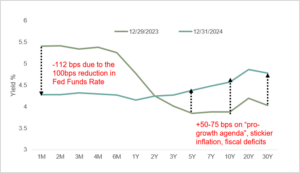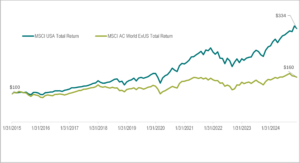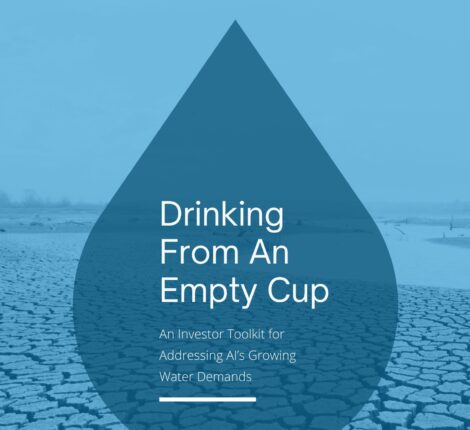Our CEO’s Q4 2024 Letter to Clients
January 28, 2025 Fourth Quarter 2024
The Gulf of America
A cartoon submitted to the Washington Post by a staff cartoonist early this year portrayed Elon Musk, Mark Zuckerburg, Jeff Bezos, and other tech bros bowing down to an enormous Donald Trump. The cartoon was nixed by the Post (owned by Bezos); we assume this was because Bezos was shown in a bad light. The cartoonist quit.
The cartoon is apt—but, in our minds, it misses another point. It is Donald Trump who should be portrayed kissing the feet of the wealthy tech CEOs who helped him secure his victory. These techies saw an opportunity and seized it, showing us exactly who they really are. Their allegiance to Trump did not come from some recent awakening, it exemplifies and reveals their capitalist drive at its most selfish; these tech bros are out for themselves. It is Donald Trump, a like-minded narcissist, who will grease the wheel of unregulated growth, and he couldn’t have been elected without their followers. Trump has been played. The support of JD Vance from out of nowhere was a key part of the plan for unbridled access, and the campaigning and campaign funds that would follow were no doubt the carrot that solidified the connection to Trump.
We believe the exponential and potential growth, reach, and use of artificial intelligence (AI) is the wave that is pushing these folks forward. Space travel, the search for “special earths” for computing, the takeover of the Panama Canal, Greenland, Canada (?) are all a part of the plan, we suspect, to build sufficient infrastructure to cool the data centers and control competition that will be necessary for this anticipated growth. The horse is out of the barn, and, while many elected officials have claimed to be all about the little guy who wants America to be great again, we believe these tech titans will be running the show, and their dollars will control the elections and the subsequent deregulation. As an example, here is an article that speaks to the impact that private wealth and power can have on a community: https://www.propublica.org/article/elon-musk-boring-company-las-vegas-loop-oversight.
There has been tremendous appreciation in the S&P 500 and the NASDAQ in the last two years. As you have heard from us in meetings and writings, most of the price appreciation has come from seven of the 500 S&P companies in reaction to the explosion of generative AI. We have participated in some of the growth (Apple, Google, Microsoft), but we missed the largest winner, Nivida, and opted out of the companies led by the tech bros mentioned above (Amazon, Tesla, Facebook) due to our very specific concerns about the CEOs (among other concerns). This is not to wholly commend the corporate structure, leadership and behavior of the other three, but our engagements with them as well as their intersection with AI, Cloud, chip and their diversified technological development strength have played an important role in the portfolio.
As we navigate this next chapter of our political and economic lives, especially considering AI, we must and will continue to consider the impact of this technological wave on the living creatures of the world, humanity included. We will focus as we have on the solutions to addressing our aging demographic, our fragile ecosystem, and the ever-expanding chasm between the haves and the have nots. We will look to AI developments that we believe can be beneficial and remain vigilant as we face the economic and social challenges that will come from poorly designed or short-sighted solutions to “growth.”
Update on Economic Outlook and NorthStar’s Strategy
Q4, 2024: Sticky inflation and resilient economy leaves Fed in a pickle
The Federal Reserve Bank (Fed) reduced the federal funds rate target (FFR) by 25 basis points to 4.25-4.50% on December 18, bringing its full-year 2024 reduction to 100 basis points (1%). However, interest rates for longer-term bonds (maturities greater than two years) increased, counteracting the Fed’s intention to bring interest rate relief to younger and lower income consumers and small businesses. This upward move in long-term rates may reflect optimism that the incoming Trump administration’s anticipated tax cuts and deregulation agenda will boost economic growth. At the same time, bond investors may be concerned about rising government debt and demand higher yields to compensate for increased risk. In announcing the rate reduction, Chairman Powell signaled a slower pace of future reductions due to uncertainty on inflation and economic outlook. Markets typically prefer easier monetary and credit conditions to stimulate economic activity, so this cautious approach to further reducing short-term interest rates has contributed to a wobble in the equity markets.
US Treasury Yield Curve
Source: Bloomberg 1/10/2025
2024: Equity markets post another year of strong returns amidst technological, political, and regulatory disruption
U.S. markets experienced double-digit returns in 2024, driven, we believe, by a confluence of factors including solid earnings reports, healthy economic data, the monetary easing cycle, and anticipation of a pro-growth agenda from the incoming Trump administration. The Nasdaq posted ~30% gains fueled by excitement and investments surrounding the adoption of Artificial Intelligence (AI) technologies. European markets rose 2.7% in response to muted economic growth. Political instability in Germany and France also weighed on the sentiment in our view. Japan posted double digit returns in local currency (9% in USD).
Macro Picture
Source: Bloomberg
Decade of US Outperformance
Source: Bloomberg 1/10/2025
These positive returns may mask the reality of what we believe are extreme technological, political, and regulatory disruption that our society is confronting. The public launch of ChatGPT in November 2022 and its unprecedented adoption by a million users within five days ignited a global frenzy around artificial intelligence. Driven by the surge of investments in power-hungry data centers to support AI models, official forecasts for increases in electricity demand through 2029 have risen from 2.8% to 16% in just two years(2022-2024)[1]. In a matter of months, we have shifted from a world talking about transition from fossil fuels to one in which new gas plants are emerging and mothballed nuclear plants may be restarted. Meanwhile, we believe the unpredictability of Trump’s policies on everything from trade tariffs to taxes is creating uncertainty in both financial markets and everyday life. This economic uncertainty is unfolding against a backdrop of growing wealth inequality, with 58 million people (1.5% of the world’s population) owning roughly 50% of global financial resources[2]. In public markets, the so-called “Magnificent Seven” stocks contributed 55% of the S&P 500 gains in 2024[3], and revenue and earnings growth for this cohort has far outpaced the growth of the remaining public companies. The decade of US exceptionalism continues with strong but concentrated relative performance of U.S. equities and the U.S. economy compared to the rest of the world.
As we have often noted, our approach to navigating what we feel are treacherous moments is to ensure that we understand your financial needs and objectives and establish an appropriate target asset allocation and liquid reserves. Secondly, we remain disciplined and committed to strategic asset allocation, maintaining appropriate diversification, and managing risk.
Selectivity in adding Fixed Income Exposure
We believe there is a high probability that interest rates will remain at current or higher levels over the mid-to-long term, as our government and others will need to fund Social Security, Medicare, and Defense programs while grappling with challenges related to ecological limits and socio-political upheaval. Since the beginning of this year, yields on 10-year bonds have see-sawed from a low of 3.6% to a high of 4.7% in response[4] to economic and inflation data points. We have maintained our discipline of buying bonds only when we believe yields are at attractive levels.
Where appropriate, we will continue to diversify across duration and add government bonds in the one to ten-year maturity range to our clients’ portfolios. We believe that bonds in this maturity range offer an optimal combination of flexibility, higher income returns, and stability for the portfolio.
High quality stocks with low debt can still provide long-term growth
Over the mid-to-long term, companies with low financial debt and that make products or sell services that we believe are beneficial to human life and that solve or mitigate some of the most pervasive problems of our time are likely to continue thriving. We focus our research on companies providing solutions and products to cope with:
- Ecological Limits: We believe our planet’s resources are increasingly under threat from ecological imbalances and decades of extractive growth.
- Aging and changing demographics: The world’s population aged 60 and over is growing faster than all younger groups and is expected to reach 1.4 billion by 2030, up from 1 billion in 2020.[5]
- Leveling the playing field: Digital transformation and new business models are enabling small businesses and entrepreneurs to compete with big business.
We aim to own and add stocks that offer competitive returns and diversification while also providing opportunities to create the greatest impact by changing corporate behavior via our shareholder activism work.
As a refresher, our investment strategy for the global equity portfolio involves independent research into each company’s growth prospects and financials combined with diligently examining the ethics of management and company behavior. The resulting portfolio, we believe, is more resilient, sustainable, and stable because of our broad-based focus. In addition, we follow our systematic quarterly rebalancing strategy in which we trim individual stocks that we feel are well past their target weights and reallocate to stocks that are under their target levels. Of course, past performance is not an indicator of future performance, and all investing involves risk!
Outside Investments [6]
As we enter the new year, our Outside Investments team has two initiatives that we hope will interest you:
Research
Our Outside Investments research function will now be part of our overall investment research team, thereby enhancing cross-fertilization of ideas and coordination of client priorities. Working with our CIO Nimrit Kang, Leah Neff and Leslie Christian will be responsible for evaluating values alignment and conducting financial research. This organizational change is proceeding smoothly and with eagerness from all parties.
Scope and Prioritization of Outside Investments
We are also eager to take the time to evaluate the set of Outside Investments that we currently recommend to our clients whose situations are conducive to holding illiquid investments that meet our criteria.
Our intention is to evaluate the geographic distribution, core business activities and focus, and liquidity/risk characteristics of our current Outside Investments with an eye toward identifying areas for more or less concentration. A part of this evaluation is to seek input from you, our clients. We hope you will continue to share with us your interests and priorities.
In addition to the above, we are in touch with the CDFIs and other organizations with which we work to understand how they are dealing with the repercussions of the election. Not surprisingly, there remains a great deal of uncertainty related to the promises and threats made during and after the election. As we wrote in last quarter’s Outside Investments section, now more than ever these organizations need our support as they work to chip away at the inequities that seem even more monumental now.
Shareholder Activism Update
Looking ahead for 2025, we remain steadfast in our commitment to driving meaningful change through our shareholder engagement efforts. For this filing season, we have re-filed proposals on fair chance employment and equal shareholder voting rights. Furthermore, given our historical work in helping PepsiCo create the first human right to water policy for a multinational company, we are revisiting this critical issue due to the rise of AI and its substantial water demands. We have become increasingly concerned with the extensive water consumption that data centers utilize to support AI workloads, specifically water used for cooling. For example, Microsoft used approximately 700,000 liters of water to train GPT-3. By 2027, global AI demand could drive water withdrawals to 4.2-6.6 billion cubic meters annually, equivalent to California’s total annual water use. With 20% of U.S. data centers across the economy located in drought-prone areas, these operations exacerbate existing water stress areas. From an environmental justice perspective, the impact of data centers on the local water supply is deeply troubling to us. With AI demand only growing, we have filed human right to water and water vulnerability risk assessment proposals at several tech companies with significant exposure to AI workloads. We have continued to collaborate with water experts including university professors, international water rights attorneys, scientists, and investigative journalists. Our engagements with these experts have been critical in informing our shareholder proposals related to datacenter water use as well as shaping our upcoming water paper.
As part of the proposal engagement process, we recently reached an agreement with Adobe for withdrawal as the company agreed to commit to engaging with its third-party data center providers regarding water conservation and water risk impacts to local surrounding communities. Engagements are underway for all other proposals; we will provide details in our next quarterly letter.
In terms of anti-ESG and DEI backlash, major brands and financial institutions have been retreating under pressure from right wing groups. Walmart recently “rolled back” its DEI commitments, ending racial equity training for staff, its supplier diversity program, and its participation in HRC’s annual benchmark index measuring workplace inclusion for LGBTQ+ employees as well as closing its Center for Racial Equity. American Airlines faces a legal battle that could set precedent for ESG related investments within retirement plans. A U.S. District Judge in Texas ruled that the airline company violated federal law by offering funds in its 401(k)-plan managed by companies that prioritize investment decisions using ESG factors over financial factors, which he argues violates ERISA. We are monitoring the developments in this case. BlackRock, the fund manager in question, also recently rolled back its climate commitments by exiting the Net Zero Asset Managers Initiative (NZAMI), joining a wave of major banks like JPMorgan Chase, Citi, and Goldman Sach. This led to the coalition suspending its activities.
Meanwhile, the shareholder proposal process is under threat from Project 2025 and the potential appointment of Paul Atkins as SEC Chair. Atkins, who had previously served as SEC commissioner between 2002-2008, has been outspokenly critical of the shareholder proposal process, particularly related to ESG issues. He has advocated for stricter proposal criteria (higher ownership thresholds, longer holding periods, refiling, etc.) and focusing only on those that are material to financial and operational performance. He believes the process to be a resource and cost burden for companies. He is yet to be confirmed by the Senate, but Atkins’ appointment could potentially impact the proposal process, causing progressive shareholders like NorthStar to pursue alternative engagement strategies.
Despite these attacks on our work and the issues we care about, there are rays of hope. While many companies have scaled back their DEI initiatives, portfolio companies like Costco and Apple are fighting against anti-DEI pressure. Both have urged shareholders to vote against proposals from the conservative National Center for Public Policy Research. These proposals seek a report on the financial risks to the respective companies of maintaining their DEI initiatives. Costco doubled down, emphasizing that its diversity has been a cornerstone of its long-term financial success and calling out NCPPR’s broader agenda as an “abolition of diversity initiatives” rather than risk reduction. While we are seeing rollbacks on progressive initiatives in the U.S., many of these brands still have global operations where they are required to report ESG related progress via programs such as the EU’s Corporate Sustainability Reporting Directive (CSRD) and Corporate Sustainability Due Diligence Directive (CSDDD).
Amid all this, we are thrilled to report on the progress of Xylem’s fair chance employment program. Following our successful 2023 engagement, Xylem has expanded its program to four new cities: Buffalo, NY; Charlotte, NC; Colorado Springs, CO; and Pittsburgh, PA. The expansion is driven by a strategy to attract and retain reliable talent as well as supporting Xylem’s DEI goals. Notably, Xylem has launched a dedicated Fair Chance Employment page on its career website, signaling to the justice-involved community that they are welcome and valued at Xylem. We have also learned that other socially responsible colleagues have reached out to Xylem to understand how they can encourage their portfolio companies to adopt similar programs.
Sincerely,
Julie N.W. Goodridge Nimrit Kang
Founder & Chief Executive Officer Chief Investment Officer
Important Disclosures
Advisory services offered through NorthStar Asset Management, Inc., a registered investment adviser. Registration does not imply any level of skill or training. This communication is for educational purposes only. It is neither an offer to sell nor a solicitation of any offer to buy any securities, investment products, or investment advisory services.
This material may contain assumptions that are “forward-looking statements,” which are based on certain assumptions of future events. Actual events are difficult to predict and may differ from those assumed. There can be no assurance that forward-looking statements will materialize or that actual results will not be materially different from those described here.
Past performance is no guarantee of future results. All investment portfolios carry risk, including the risk of loss. No assurances can be given that NorthStar will attain its investment objective or that an investor will not lose invested capital.
This material is for informational purposes only and is not intended to serve as a substitute for personalized investment advice or as a recommendation of or solicitation of any particular security, strategy, or investment product. The forecasts, opinions, and estimates expressed in this report constitute our judgment as of the date of this letter and are subject to change without notice based on market, economic, and other conditions. The assumptions used in our forecasts concern future events over which we have no control and may turn out to be materially different from actual experience.
NorthStar does not provide legal or tax advice, and nothing contained in these materials should be taken as legal or tax advice. Although NorthStar believes the data presented here to be reliable, we do not guarantee the accuracy of third-party data. Links to third party sites are provided for your convenience and do not constitute an endorsement. These sites may not have the same privacy, security or accessibility standards.
Indices are presented herein for illustrative and comparative purposes only. Such indices may not be available for direct investment, may be unmanaged, assume reinvestment of income, do not reflect the impact of any trading commissions and costs, management fees, or performance fees, and have limitations when used for comparison or other purposes because they, among other things, may have different strategies, volatility, credit, or other material characteristics. In considering performance results discussed here, prospective clients should note that equity portions of individually managed accounts may differ from the results shown here because of client-specific restrictions, client circumstances, client legacy positions, different fee and expense structures, actual trading, tax considerations, and other reasons.
[1] https://gridstrategiesllc.com/wp-content/uploads/National-Load-Growth-Report-2024.pdf
[2] Source: UBS Global Wealth Databook 2024
[3] Source: Bloomberg; Unless otherwise noted, all data and numbers are sourced from Bloomberg
[4] Bloomberg
[5] Source: United Nations Department of Economic and Social Affairs, World Population Prospects 2022
[6] Outside Investments are privately placed with various types of entities, as described above. Privately placed investments generally carry higher risk and are not publicly traded. In addition to the risks of equity, (which include, but are not limited to, changes in revenue, margins, earnings, dividends, cash flow, balance sheet, leverage, liquidity, solvency, legal matters, negative publicity, brand image, and general market volatility) and the risks of fixed income investing (such as credit risk, interest rate changes and the yield curve, inflation, default, monetary policy changes, government instability, and other risks), Outside Investments are typically illiquid and may not be sold easily. More information on the risks of Outside Investments may be found in the applicable product offering materials or in our ADV 2A brochure, located at: https://northstarasset.com/wp-content/uploads/2024/04/2024.0321-NSAM-FYE-2023-FYE-ADV-Part-2A.pdf.







